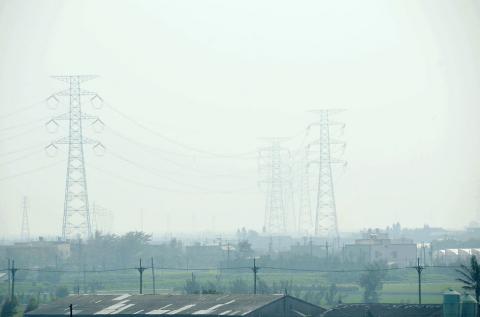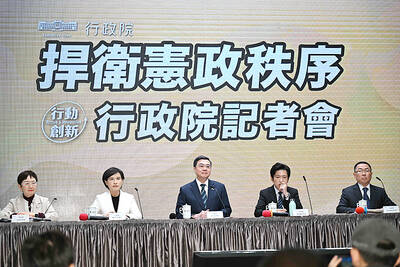Central Taiwan might be designated a top-grade air pollution control zone, while a Taichung City bylaw aiming to limit coal burning to curb air pollution might be approved by the central government next week, the Environmental Protection Administration (EPA) said.
At a meeting of the legislature’s Social Welfare and Environmental Hygiene Committee yesterday, EPA Minister Wei Kuo-yen (魏國彥) said that by the end of this year, Taichung, Changhua and Nantou might be designated as class-three air pollution control zones, where pollution is most severe according to the agency’s three-class categorization system.
The area was identified for potential designation as a class-three zone due to high concentrations of PM2.5 — fine particulate matter measuring 2.5 micrometers or less in diameter — Wei said, in response to New Power Party Legislator Hung Tzu-yung’s (洪慈庸) questions about an emissions cap in the area to curb pollution.

Photo: CNA
An area where air quality levels fall below the standard for three consecutive years can be recognized as a class-three air pollution zone, in which stricter standards apply to reduce emissions in the area.
According to an analysis of PM2.5 data collected in the past three years and announced by the EPA earlier this year, the whole nation, excluding Hualien and Taitung, qualify for class-three zone recognition.
Hung also asked whether the EPA would reject a Taichung bylaw to ban petroleum coke and reduce the use of coal in the city by 40 percent in four years, as the agency last year rejected a similar Yunlin bylaw that aimed to ban coal burning.
The EPA said the ban was beyond the county’s jurisdiction.
“The Taichung bylaw and Yunlin bylaw are different in content. The Taichung bylaw is less in conflict with central government laws and is likely to be approved. The EPA will submit an analysis of the Taichung bylaw to the Executive Yuan for review next week,” Wei said.
In related news, Democratic Progressive Party Legislator Liu Chien-kuo (劉建國) said participants of religious activities are at higher risk of PM2.5 exposure, as PM2.5 levels inside a temple that burns incense and ghost money could be three times higher than the highest level of the EPA’s 10-level PM2.5 index.
As a series of festivals celebrating Matsu are scheduled to begin soon, Liu called on the EPA to dispatch air quality monitoring vehicles to join religious processions and announce real-time pollution data and associated health risks of different religious activities, such as letting off firecrackers and burning incense.
“According to an EPA study, incense emits 75 to 700 micrograms of PM2.5 per cubic meter, which is 10 times higher than the highest level of the EPA’s PM2.5 index. I will personally join the processions and monitor air quality with a handheld device,” Wei said.

The US government has signed defense cooperation agreements with Japan and the Philippines to boost the deterrence capabilities of countries in the first island chain, a report by the National Security Bureau (NSB) showed. The main countries on the first island chain include the two nations and Taiwan. The bureau is to present the report at a meeting of the legislature’s Foreign Affairs and National Defense Committee tomorrow. The US military has deployed Typhon missile systems to Japan’s Yamaguchi Prefecture and Zambales province in the Philippines during their joint military exercises. It has also installed NMESIS anti-ship systems in Japan’s Okinawa

‘WIN-WIN’: The Philippines, and central and eastern European countries are important potential drone cooperation partners, Minister of Foreign Affairs Lin Chia-lung said Minister of Foreign Affairs Lin Chia-lung (林佳龍) in an interview published yesterday confirmed that there are joint ventures between Taiwan and Poland in the drone industry. Lin made the remark in an exclusive interview with the Chinese-language Liberty Times (the Taipei Times’ sister paper). The government-backed Taiwan Excellence Drone International Business Opportunities Alliance and the Polish Chamber of Unmanned Systems on Wednesday last week signed a memorandum of understanding in Poland to develop a “non-China” supply chain for drones and work together on key technologies. Asked if Taiwan prioritized Poland among central and eastern European countries in drone collaboration, Lin

NO CONFIDENCE MOTION? The premier said that being toppled by the legislature for defending the Constitution would be a democratic badge of honor for him Premier Cho Jung-tai (卓榮泰) yesterday announced that the Cabinet would not countersign the amendments to the local revenue-sharing law passed by the Legislative Yuan last month. Cho said the decision not to countersign the amendments to the Act Governing the Allocation of Government Revenues and Expenditures (財政收支劃分法) was made in accordance with the Constitution. “The decision aims to safeguard our Constitution,” he said. The Constitution stipulates the president shall, in accordance with law, promulgate laws and issue mandates with the countersignature of the head of the Executive Yuan, or with the countersignatures of both the head of the Executive Yuan and ministers or

CABINET APPROVAL: People seeking assisted reproduction must be assessed to determine whether they would be adequate parents, the planned changes say Proposed amendments to the Assisted Reproduction Act (人工生殖法) advanced yesterday by the Executive Yuan would grant married lesbian couples and single women access to legal assisted reproductive services. The proposed revisions are “based on the fundamental principle of respecting women’s reproductive autonomy,” Cabinet spokesperson Michelle Lee (李慧芝) quoted Vice Premier Cheng Li-chiun (鄭麗君), who presided over a Cabinet meeting earlier yesterday, as saying at the briefing. The draft amendment would be submitted to the legislature for review. The Ministry of Health and Welfare, which proposed the amendments, said that experts on children’s rights, gender equality, law and medicine attended cross-disciplinary meetings, adding that